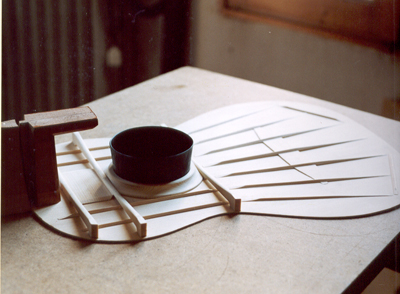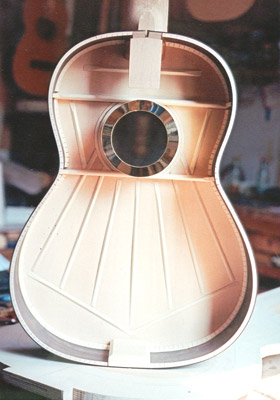DjangoBooks.com
Welcome to our Community!
Categories
- 17.9K All Categories
- 394 General
- 255 Welcome
- 10 Archtop Eddy's Corner
- 74 CD, DVD, and Concert Reviews
- 29 FAQ
- 9 Gypsy Jazz Italia
- 17 Photos
- 24 Gypsy Picking
- 3 Unaccompanied Django
- 1 Pearl Django Play-Along Vol.1
- 1 Gypsy Fire
- 21 Gypsy Rhythm
- 551 Gypsy Jazz University - Get Educated
- 104 Gypsy Jazz 101
- 175 Repertoire
- 128 History
- 88 Technique
- 39 Licks and Patterns
- Daniel Givone Manouche Guitare Method Users Group
- 17 Eddie Lang Club
- 1K Gypsy Jazz Gear
- 648 Guitars, Strings, Picks, Amps, Pickups and Other Accessories
- 316 Classifieds
- 36 Recording
- 38 Other Instruments
- 17 Violin
- 3 Mandolin
- 6 Accordion
- 3 Bass
- 9 Woodwinds
- 197 Gypsy Jazz Events
- 78 North America
- 81 Europe
- 38 International
In this Discussion
Who's Online 0
Tornavoz
 MichaelHorowitz
SeattleAdministrator
MichaelHorowitz
SeattleAdministrator
i just became aware of the tornavoz, a resonator like cone added to the soundhole of a classical guitar, which was pioneered by the legendary Antonio Torres (father of the classical guitar). See photo below.


It's interesting how so many of the ground breaking luthiers of the last 2 centuries tried to implement some sort of resonator which ultimately was rejected by the public (Macafferi's resonator and Loyd Loar's Virzi tone producer come to mind).
The tornavoz fell out of favor among classical builders by the 20s, but there seems to be a resurgence of interest in it. Francisco Tárrega, the legendary pioneer of classical guitar, had a maple Torres guitar with a tornavoz. He considered it one of best instruments he ever owned noting that:
“In addition to the spontaneity of sound, perhaps due to its tornavoz, there was a clear, warm timbre as if it were of gold. The balance between bass and treble was proportionally exact in volume and the duration of its vibrations equally generous throughout the fingerboard. It sufficed to finger a perfect chord in order that, by plucking only the three bass notes one could clearly perceive the harmonics of the other strings.”
This guitar had a soundboard that was less then 1mm thick, wow! But the top did eventually cave in...but I bet it was fun while it lasted...he eventually got a rosewood guitar sans tornavoz that he liked even better.
Anyway, it's an interesting anecdote in the development of the guitar. More here: http://www.guitarsalon.com/articles.php?articleid=38
Who wants to be the first to have a Selmer style guitar with a tornavoz?




It's interesting how so many of the ground breaking luthiers of the last 2 centuries tried to implement some sort of resonator which ultimately was rejected by the public (Macafferi's resonator and Loyd Loar's Virzi tone producer come to mind).
The tornavoz fell out of favor among classical builders by the 20s, but there seems to be a resurgence of interest in it. Francisco Tárrega, the legendary pioneer of classical guitar, had a maple Torres guitar with a tornavoz. He considered it one of best instruments he ever owned noting that:
“In addition to the spontaneity of sound, perhaps due to its tornavoz, there was a clear, warm timbre as if it were of gold. The balance between bass and treble was proportionally exact in volume and the duration of its vibrations equally generous throughout the fingerboard. It sufficed to finger a perfect chord in order that, by plucking only the three bass notes one could clearly perceive the harmonics of the other strings.”
This guitar had a soundboard that was less then 1mm thick, wow! But the top did eventually cave in...but I bet it was fun while it lasted...he eventually got a rosewood guitar sans tornavoz that he liked even better.
Anyway, it's an interesting anecdote in the development of the guitar. More here: http://www.guitarsalon.com/articles.php?articleid=38
Who wants to be the first to have a Selmer style guitar with a tornavoz?











Comments
http://www.luciocarbone.it/liuteria_bs.htm#copieTorres
I'll ask him what he thinks about the tornavoz, I had never heard about it!
http://www.frenchguitars.com/tornavoz.html
http://www.hago.org.uk/faqs/contrabass/construction.php
They really do effect these particular contrabass guitars. Listen here:
http://www.hago.org.uk/faqs/contrabass/ ... -after.php
-Chuck
Most guitar bodies are tuned somewhere around G or A. The thing about it is, that if you want to do a lot of first position playing or open chord playing or drop-tunings or whatever, you might want a guitar whose bass is accentuated nearer those frequencies. Not coincidentally - if you take a ~0.6 square foot chamber (assume 3.75" x 18.5" x ~14" being an average guitar) and give it a 3" port that is about 2.75" deep.... you tune it to ... you guessed it... about 80hz which is approximately a low E.
It is, in a fashion, a resonator. Likely the thing that is resonating is not what you'd guess though... the plug of air in the vent is resonating - or rather it's moving in and out fast - I guess you could call that resonating; Helmholz did - and its mass is increased when you lengthen the port... higher mass = more momentum = slower to change directions = lower frequency... roughly... there's more to it than that, especially in a guitar where at least one of the surfaces of the chamber is a passive radiator (resonator) with its own moving mass / resonance etc. But that's basically the concept.